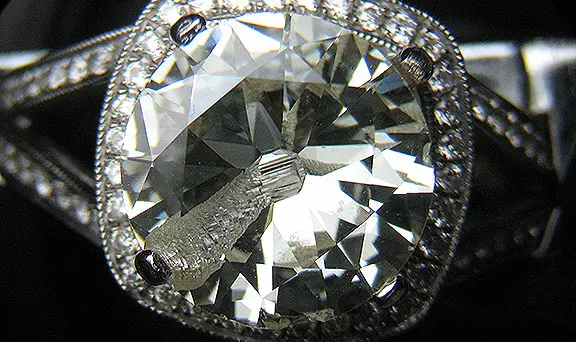
“Thank you so much for all you’ve taught me, and all you will teach me! I just changed careers and got a job with Sterling Jewelers! They were very excited that I was getting my RGA. That was one of the reasons for me getting this job, and I owe it all to you and the ISG! You truly have changed my life! thank you again.” Bridget F., Illinois

Registered Gemologist Appraiser Diploma Program $2,995.00
Payment Plan now available at this link: RGA Payments with Klarna
Become an ISG Registered Gemologist Appraiser
Unlock your potential as a certified expert in the world of fine gemstones and jewelry with the ISG Registered Gemologist Appraiser (RGA) program. As an RGA, you will gain the professional recognition and expertise needed to excel in the ever-growing and dynamic jewelry industry.
Professional Gem Equipment Package Included
The ISG Registered Gemologist Appraiser Program comes complete with the ISG Gem Equipment Package for your study and to keep. This special package includes the items you see in the image below, which includes everything you need to get started on your journey into becoming a professional gemologist and jewelry appraiser. This is your gem equipment set to keep as part of your registration. This is the same professional quality equipment we use here in the ISG lab. Gem Equipment package will ship 3 days after your paid RGA registration. Please note: Students on the ISG Payment Plan will not receive their gem equipment package until you complete the course program and are ready for your practical, hands-on study.
Your Gem Equipment Package will include (specific item designs may change due to availability):
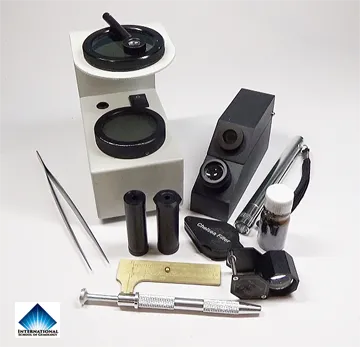
- ISG Polariscope with conoscope,
- ISG Refractometer, RI Liquid, Polarizing Filter
- Diffraction Grating Spectroscope,
- 10x Jeweler’s Loupe
- Calcite Dichroscope,
- Chelsea Filter,
- Brass MM Gauge,
- Gemstone Tweezers
Please Note: The RGA program is available without the Gem Equipment package for $2495.00 for those who already own equipment or wish to buy equipment elsewhere. Please be aware that gem equipment is required to complete this program.
Why Choose the ISG RGA Program?
The International School of Gemology (ISG) is renowned for its advanced training and educational excellence. The RGA program is designed to provide you with in-depth knowledge and hands-on experience in the art of gemstone evaluation and appraising, allowing you to become a trusted authority in your field.
World-Class Education: Gain access to the most up-to-date gemology courses and materials taught by leading industry professionals.
Global Recognition: The ISG Registered Gemologist Appraiser certification is recognized globally as a mark of excellence in gemstone appraisal.
Hands-On Training: Learn the essential techniques for accurately grading, valuing, and appraising diamonds, gemstones, and jewelry.
Career Advancement: Enhance your career prospects by becoming an ISG RGA, giving you a competitive edge in the market.
Exclusive Resources: Enjoy access to a library of gemological tools, grading software, and a community of experts to support you throughout your journey.
What Will You Learn?
 The RGA program covers a wide range of essential topics, including:
The RGA program covers a wide range of essential topics, including:
- Diamond Grading & Evaluation: Understand the 4 C’s of diamond grading — Cut, Color, Clarity, and Carat weight — and learn to evaluate and grade diamonds.
- Colored Gemstones: Dive deep into the study of colored gemstones, their properties, treatments, and market evaluation.
- Lab Techniques & Instrumentation: Get hands-on experience using gemological tools and instruments like microscopes, refractometers, and polariscopes to analyze gemstones.
- Created and Treated Gemstones: Learn about the science behind laboratory grown gemstones including what gemstones can be duplicated in a lab, and how to identify most, including lab created diamonds.
- Jewelry Appraisal: Understand the intricate processes of appraising both loose gemstones and finished jewelry pieces.
- Ethical Standards: Learn about the ethical considerations and professional conduct expected from an appraiser.
- Litigation and Expert Witness: Learn how to become a highly paid Expert Witness and Litigation Consultant for high value jewelry claims and litigation.
Who Should Enroll?
Gemologists seeking advanced certification and specialization.
Jewelers looking to enhance their appraisal skills and broaden their service offerings.
Entrepreneurs wanting to start their own appraisal business or expand an existing one.
Collectors who wish to deepen their understanding of gemstones and jewelry.
How the Program Works
Study at Your Own Pace: Our flexible learning platform allows you to access course materials anytime and anywhere. Learn from industry leaders and experts without disrupting your schedule.
Certification: Upon completion, you will receive the prestigious ISG Registered Gemologist Appraiser designation, enhancing your credentials and setting you apart in the market.
Continual Support: As a graduate, you will have access to ongoing resources and networking opportunities, ensuring you remain updated with the latest developments in the industry.
Get Started Today
 Official Appraisal Seal
Official Appraisal Seal
You will also receive your formal ISG Registered Gemologist Appraiser appraisal seal to use on all of your official documents and appraisals.
Technical and Lab Support
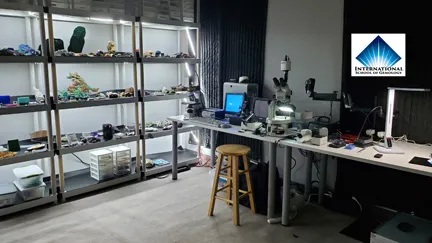 Finally, you will receive technical support from our state-of-the-art gemological lab to help you with those difficult evaluations. This is all included in your ISG Registered Gemologist Appraiser registration. (fees may apply for some services.)
Finally, you will receive technical support from our state-of-the-art gemological lab to help you with those difficult evaluations. This is all included in your ISG Registered Gemologist Appraiser registration. (fees may apply for some services.)
 Instructor:
Instructor:
Your instructor is Robert James FGA, GG. Mr. James is a Fellow of the Gemmological Association of Great Britain, a Graduate Gemologist of the Gemological Institute of America, and a former Certified Gemologist of the American Gem Society. He is a state-licensed Property and Casualty Insurance Adjuster with 50 years of experience in jewelry-related litigation and expert witness work in the United States and Europe. He has served as an expert witness and litigation consultant in U.S. State and Federal Courts and in the United Kingdom. He holds a Business Law Certification from Cornell Law School and is a former Senior Gemologist and Special Investigations Unit (SIU) investigator with USAA Insurance.
- Instructor Email Contact: studentinquiry@schoolofgemology.com
- Instructor Phone Contact: (001) 210-464-1473

How to Begin to Start Immediately
- To pay a one-time tuition payment and begin immediately, use any credit card on PayPal or our new STRIPE Credit Card Payment Gateway.
- SSL Secure Payments can be made through STRIPE or PAYPAL.
- Click on the BUY NOW button on the upper right side of this page.
- The payment gateway will take you to the payment system icon.
- Once you receive payment confirmation, you will be brought back to your course or to the Gemology.pro website to begin. Either way, go to the course home page to begin. You can also access the course page through your Profile Page, which is available under your username in the top right corner of the home page.
- Once you have returned to the course home page, click the Start the Course button to begin immediately.
- Once you complete the program, you will receive your Registered Gemologist Appraiser Diploma and be listed in the Insurance Registry.
- Please be sure and read the ISG Student Registration Agreement Form here: Student Registration Agreement
Registered Gemologist Appraiser Program Syllabus Below
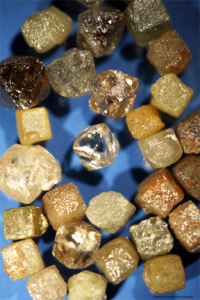 History of Diamonds
History of Diamonds
Diamonds. The very name conjures up visions of wealth, intrigue, and fortunes. Are they real or imagined? Is diamond really the “King of Gems” as claimed by many advertisements? And is it really true that Diamonds are Forever ™, as claimed in the now famous ad slogan created by N. W. Ayers in the 1940s, has been voted one of the best ad slogans of the Twentieth Century?
The truth is diamonds have a somewhat shady past and uncertain future. Why? Because the entire diamond market has been based on a monopoly market system that has lasted for over 100 years. In fact, it is one of the only monopolistic markets that has survived and flourished within the structure of the modern capitalistic world economy. Before we talk about the current and future status of the diamond markets, let’s go back in time and understand just how these crystals of pure carbon became such a mainstay in the world economy.
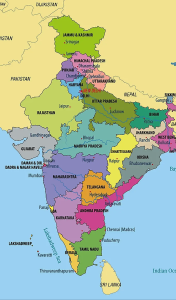 Golconda, India
Golconda, India
India was the place of the original discovery of diamonds dating back almost 2400 years ago. In fact, until the 1730s, India was the world’s only known source of diamonds. The diamonds were first found in fields after thunderstorms had moved through the area of central India. The locals believed the diamonds were formed by lightning strikes hitting the ground and were therefore considered a gift from the gods. It was unknown to these early diamond gatherers that they lived over a colluvial deposit of diamonds, a deposit close to a diamond pipe where the diamonds were being re-deposited by wind and rain. And when the thunderstorms moved across the area, the rain would wash away a layer of the topsoil thereby exposing the diamonds contained in the ground deposits. As these thunderstorms produced a lot of lightning strikes, it was therefore assumed that these lightning strikes actually created the diamonds.
The region of these earliest known diamond finds is Golconda, located between two rivers in central India. Most of the diamonds were found in alluvial deposits of those rivers. Alluvial deposits are those found in rivers and stream beds where water still flows. This was the primary source of the Indian diamonds before the prime volcanic source was located.
It is essential to know that most of the world’s most important diamonds come from the Golconda region of India. Names such as the Koh-i-Noor, the Orlov, the Hope, and the Sancy diamonds all came from this region. To this day, these diamonds are considered the finest diamonds in the world. Virtually all of these diamonds came from the alluvial deposits in the Golconda region, and it was only with the find of the prime source at the Majhgawab lamproite diamond bearing volcanic pipe, that the true source of the Indian diamonds was finally known. And to this day, the Indian diamond deposits produce almost 20,000 carats annually…after almost 2400 years of production! The Golconda name is often used to refer to the finest quality diamonds since the deposits there produced some of the finest in the world. And on occasion, you may get a customer who requests a “Golconda diamond.” You should be aware of this name and the history behind it.
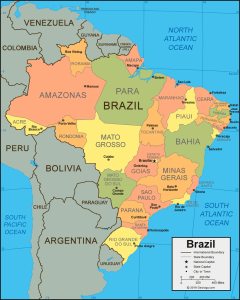 Brazil
Brazil
As the European demand for diamonds grew quickly, the production of the Indian diamond deposits began to dwindle by comparison. A new source was needed and was found by accident. In 1725 a group of gold miners working alluvial deposits in the mountains of Brazil stumbled upon an area that produced diamonds mixed in with their gold ore. A new diamond source had been found!
Two aspects of the Brazilian diamond find proved to be necessary. First, once formal diamond prospecting was begun, it was found that many areas of Brazil produced diamonds. In fact, no less than 12 regions encompassing the entire country produced diamonds in various qualities and quantities. These ranged from the southern region outside of Sau Paulo to an area encompassing the entire Amazon River delta. Second was the fact that Brazil could produce a massive amount of diamonds from her many sources, so many diamonds were being produced that more diamonds were being produced than the European markets could absorb. The result was that diamond market prices fell by almost 70% shortly after the Brazilian diamond discovery.
With the availability of a huge source of diamonds at cheap prices, the demand for diamonds in Europe increased. And eventually the easily mined alluvial diamond deposits in Brazil started to diminish as the deposits were worked out. This caused an eventual shortage of rough diamonds in a market of huge demand, which in turn caused prices to increase dramatically. As is the case in any economy of supply and demand, the sudden decrease in diamond availability in the late 1740s, and the ensuing dramatic increase in price, caused the diamond markets to virtually collapse, as only the very rich could afford to own diamonds once again.
The Age of Mercantilism
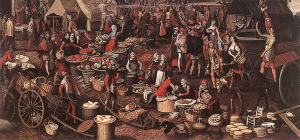 An interesting fact about 18th century European economies would make an impact on the diamond markets in the mid-1740s that lasts to this day. During this time the main economic theory was not one of capitalism, but instead one of mercantilism. Mercantilism was Europe’s first effort to establish international trading partners and build a national wealth. The key was that certain trades, such as ship building and banking, were far more profitable than being a cobbler (shoemaker) or cartwright (one who makes carts). The result was that those who established themselves in ship building would want their children also to have the ship building business. Not just to carry on the family tradition, but to carry on the family wealth.
An interesting fact about 18th century European economies would make an impact on the diamond markets in the mid-1740s that lasts to this day. During this time the main economic theory was not one of capitalism, but instead one of mercantilism. Mercantilism was Europe’s first effort to establish international trading partners and build a national wealth. The key was that certain trades, such as ship building and banking, were far more profitable than being a cobbler (shoemaker) or cartwright (one who makes carts). The result was that those who established themselves in ship building would want their children also to have the ship building business. Not just to carry on the family tradition, but to carry on the family wealth.
The result of mercantilism was that many trades of the day became family heirlooms. The knowledge and trade would simply be passed down from father to son, and it was understood that the son of a cobbler would become a cobbler. The son of a banker would become a banker. The problem was that if you were born into a cobbler’s family…you were stuck. That was what you were expected to do. That was the trade you were taught because you spent your growing up years learning the trade from your father, who learned it from his father, and so on. And you were expected to carry on the tradition and teach it to your son.
Here is where mercantilism had a long-ranging impact on the diamond markets.
One of the facts about mercantilism was that once your family was involved in a business, you were pretty much there the rest of your life. And there were trades that no one wanted to do…either because they were demeaning or because they did not make any money. In 1740, in Europe, diamonds did not make any money. The supplies were gone, the cutting ability was not well advanced due to lack of technology, and the future of the diamond markets was quite glum as both the Indian and Brazilian deposits were virtually wiped out with no more known sources to draw. It was also during this time that most European countries were monarchies. Meaning that the king or queen wielded a lot of power. So much that they could decide who was awarded what level on the mercantilism ladder of respectability and profitability. Since the Jewish communities of most European countries were considered of low status, it was determined to limit the Jewish ability to enter into a profitable trade. So….the Jews were severely limited as to what trades they could enter to ensure that they had the lowest economic potential of the day. And in 1740 Europe, one of the most unprofitable trades you can work in was….diamond cutter or diamond merchant. So, one of the few mercantile trades that Jewish workers were allowed to work in was…diamonds.
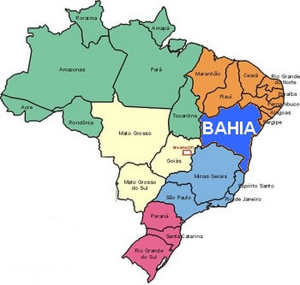 What the mercantilism system did not anticipate, however, was that in 1850 a significant diamond discovery would be made in the Bahia region of Brazil. And once again, the diamond markets flourished as supply and demand increased significantly. Of course, by this time the only people who were involved in the diamond markets were members of the Jewish communities…everyone else abandoned the trade as it had become something of a low status trade. And it was with few exceptions that only the Jewish diamond cutters knew how to cut diamonds properly, so they flourished along with the new diamond demand throughout Europe. Something quite the opposite of what the governing powers expected at the time. And despite a depressed market in the early 1860s, the theory of mercantilism ensured the Jewish community a thriving trade, now centered in the Belgian town of Antwerp, as the art of diamond cutting was passed down from father to son within their families. Due to it taking many years to learn how to cut a diamond properly, this system served quite well as master diamond cutters could start their training at a very young age as they helped with the family business.
What the mercantilism system did not anticipate, however, was that in 1850 a significant diamond discovery would be made in the Bahia region of Brazil. And once again, the diamond markets flourished as supply and demand increased significantly. Of course, by this time the only people who were involved in the diamond markets were members of the Jewish communities…everyone else abandoned the trade as it had become something of a low status trade. And it was with few exceptions that only the Jewish diamond cutters knew how to cut diamonds properly, so they flourished along with the new diamond demand throughout Europe. Something quite the opposite of what the governing powers expected at the time. And despite a depressed market in the early 1860s, the theory of mercantilism ensured the Jewish community a thriving trade, now centered in the Belgian town of Antwerp, as the art of diamond cutting was passed down from father to son within their families. Due to it taking many years to learn how to cut a diamond properly, this system served quite well as master diamond cutters could start their training at a very young age as they helped with the family business.
The real impact was just beginning…
South Africa
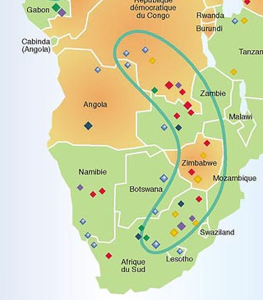 On a December day in 1866, a young man named Erasmus Jacobs found a transparent and very shiny stone on his father’s farm that was located alongside the Orange River. This turned out to be the first of what would become an avalanche of diamonds from the South African mines and would start one of the world’s greatest monopolies that would last for over 100 years. There were two important events that combined to make this one of the most momentous events in world economic history.
On a December day in 1866, a young man named Erasmus Jacobs found a transparent and very shiny stone on his father’s farm that was located alongside the Orange River. This turned out to be the first of what would become an avalanche of diamonds from the South African mines and would start one of the world’s greatest monopolies that would last for over 100 years. There were two important events that combined to make this one of the most momentous events in world economic history.
First, it proved to be the most significant find of diamond deposits in the history of the world. According to many sources, the South African mines produced more diamonds in the next 15 years than the Indian deposits had produced in 2,000 years. The African diamond deposits proved to be extremely widespread and extremely rich.
The second event was the ending of the Civil War in the United States that ushered in a period of great prosperity and a resultant high demand for diamond jewelry. Plus…with the industrial age just now dawning, the demand for diamonds for industrial purposes was also growing. These were joined with an already healthy diamond market established in Europe. Together they all created a huge demand for diamonds. And many men got on ships of all shapes and sizes heading to the South African diamond fields to make their fortunes.
Until now, the majority of diamonds found were in alluvial deposits. However, with the discovery of South African diamonds, alluvial deposits could be traced upriver until the prime source was found. These were called kimberlite pipes and were the remnants of ancient volcanoes that had discharged the diamonds from deep inside the earth millions of years earlier. More on that in a later lesson. For now, it will be important for you to know that the South African diamond deposits were traced back to their original source, and now diamonds could be dug from the earth…rather than just washed from a stream bed.

The problem became one of too many people trying to dig too many diamonds out of relatively small places in the ground.
The main mining effort was at the Kimberley mine which at the time was the largest diamond mine in the world. Each miner was able to stake a claim measuring 31 feet or 9.44 meters square. And since everyone had different methods of mining encompassing variable numbers of helpers and variable techniques, each claim was worked at different speeds. And different mining speeds meant that the claims dug into the earth at different rates. This allowed some claims to quickly be several meters deeper than the one next to it, allowing for a very dangerous situation as the higher would collapse onto the lower. Clearly something needed to be done to make the mining more uniform, more profitable and less dangerous. Enter Cecil Rhodes and Barney Barnato.
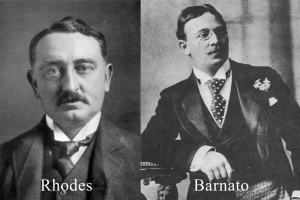 These two gentlemen arrived in South Africa in the early 1870s and separately began a process of accumulating claims from other miners in an effort to gain overall control of the Kimberley mine. The concept being that a single unified effort at mining would be more profitable and bring the control of the distribution of diamonds under a single office. The market could then be better controlled as the supply of diamonds would be controlled by one man rather than a huge number of individual miners.
These two gentlemen arrived in South Africa in the early 1870s and separately began a process of accumulating claims from other miners in an effort to gain overall control of the Kimberley mine. The concept being that a single unified effort at mining would be more profitable and bring the control of the distribution of diamonds under a single office. The market could then be better controlled as the supply of diamonds would be controlled by one man rather than a huge number of individual miners.
The ensuing battle between these two men has been the subject of many books and is a story worthy of your continued research. The fight for control of the Kimberley mine was nasty in size and scope, encompassing many legal battles and bar room brawls. The necessity of a unified mining effort was further confirmed when the mine reached a particular depth and ground water began flooding vast areas of the mine. Many miners were quick to sell their claims as they believed there was no longer any reason to own that claim. The truth was that Cecil Rhodes had a plan to pump the water from the deepening claims, thereby making them continue to produce profits far in excess of the bargain prices he had paid the others who had given up on them.
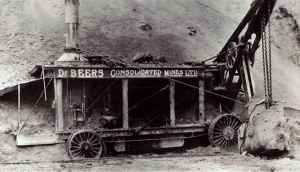 Eventually, Cecil Rhodes won the battle of control of the Kimberley mine and bought out his rival, Barney Barnato, for a price of what would be over US$25,000,000.00 in today’s dollars to consolidate the Kimberley mine into single ownership. This was the birth of the De Beers Consolidated Mines Company which exists to this day.
Eventually, Cecil Rhodes won the battle of control of the Kimberley mine and bought out his rival, Barney Barnato, for a price of what would be over US$25,000,000.00 in today’s dollars to consolidate the Kimberley mine into single ownership. This was the birth of the De Beers Consolidated Mines Company which exists to this day.
Central Selling Organization
Of course, for the De Beers Consolidated Mines to have real control of their distribution, it was required that they not have to deal with all of the small-time diamond merchants in order to sell their production. In true form to the legacy of Cecil Rhodes, a unified distribution network was established between De Beers Consolidated Mines in South Africa, and what was known as the Central Selling Organization in London. The CSO as it was called was established to serve as the distribution channel for the diamonds and to help control the market and prices of diamonds. This organization served to control virtually the entire world production of diamonds…since virtually all came from the South African mines owned by De Beers…by withholding rough when prices were low and selling more rough when prices were higher. This established De Beers as holding a monopoly on the world diamond markets, a matter of great concern to the US government since monopolies are against the law in the USA.
The result was that De Beers could not directly do business in the United States, in spite of the fact that the US had become its biggest customer. The US jewelers were by far the driving force behind the world demand for diamonds, and yet the De Beers organization could not participate in the market. For many years the De Beers organization paid the US advertising company, N. W. Ayers, to handle their public relations and promotion of diamonds in the United States. In fact, it was N.W. Ayers who come up with the famous De Beer’s slogan: A Diamond is Forever. ™ With the mines under their control, the distribution under their control, the prices under their control, and the marketing under their control, De Beers finally had a complete and utter monopoly on the world diamond markets. And here is where the story turned a bit ugly.
World War II
With the outbreak of World War II came a worldwide demand for many commodities to power the war machines of the Allied and Axis powers. One of these commodities was industrial grade diamonds needed for grinders and cutting blades to speed up production of war machines. And, you guessed it, De Beers controlled the whole world’s production of industrial grade diamonds. And since De Beers was only interested in who was willing to pay the most for their products, and not so much on what their customer’s politics were, the scramble for industrial grade diamonds put great amounts of profits into the pockets of the De Beers owners regardless of who made the purchase.
Although this did not sit well with the US government, they were relying on the US industrial complex to provide some alternatives to De Beer’s strangle hold on this important war time commodity. Enter General Electric.
 The General Electric company set about to create the world’s first synthetic diamonds. Many other gemstones had been synthesized for many decades. It was only natural to believe that diamonds could also be synthesized, thereby taking the De Beers monopoly out of the production chain and saving the US government millions of dollars. And the GE Company was successful…to a point. Although they were able to synthesize diamonds, they reported that they were not able to do so in the volume and quality required for military and industrial purposes. This turned out not to be totally true….
The General Electric company set about to create the world’s first synthetic diamonds. Many other gemstones had been synthesized for many decades. It was only natural to believe that diamonds could also be synthesized, thereby taking the De Beers monopoly out of the production chain and saving the US government millions of dollars. And the GE Company was successful…to a point. Although they were able to synthesize diamonds, they reported that they were not able to do so in the volume and quality required for military and industrial purposes. This turned out not to be totally true….
What was later found out was that De Beers had actually conspired with GE to keep the new synthetic diamonds off the market so that De Beers would not lose their monopoly. And long after the situation occurred the nature of De Beers’ involvement was found out, and De Beers was charged with crimes against the United States by way of their monopoly over the diamond markets. For some reason, GE was never really brought to task over this matter, or so it has been reported. The actual events after the revelation of this situation are still up to interpretation as there are many stories surrounding the issue. One thing was certain; no officer of the De Beers company could enter into the United States without being immediately arrested. And for many decades the Central Selling Organization had to business in the US from a distance and through third parties because they could not set foot inside any US property for fear of arrest.
In 2004 De Beers finally pleaded guilty to the price fixing of industry diamonds that dated back to the World War II events and continues until current times. De
Beers paid a US$10 million dollar fine and cleared the way to enter into the United States market as a formal business presence.
It was during this time that De Beers ceased using the name and structure of the Central Selling Organization and formed the Diamond Trading Company. At this point the DTC was in charge of the sale and distribution of rough diamonds from many world sources. And De Beers?
After many decades of making billions of dollars from operating a monopoly of the diamond markets to wholesalers and retail jewelers, De Beers is now going into the retail business in competition with their own clients through their De Beers retail jewelry stores that recently opened in New York and other locations.
Conflict Diamonds
One of the really ugly stories that surfaced in the last few years is in regard to what is known as conflict diamonds. These are diamonds that have come from known areas where civil wars are being waged to control the diamond resources of diamond producing countries. The really ugly part is that there is such a nasty fight being waged for that control where local citizens are brutalized by the warring factions.
The brutality of these conflicts, particularly in Angola and Sierra Leone, has left many children without arms and legs…as one of the methods used to control the local population by the various militias is to sever the limbs of many of the locals to instill fear in everyone. The purpose obviously being to control them by fear so the local population will not assist legitimate government actions to control the problem.
There are many who believe that De Beers is complicit in this problem. Mainly because for many years no diamond of any size could be bought or sold without De Beers being in control of the pipeline somewhere along the way. And given De Beers total control of the diamond markets for many years, there was no way the conflict diamonds would find a market without De Beers being willing to buy them.
How much of this is true? There is a lot of speculation that common sense requires to be taken with a degree of credibility. Actual proof is missing since most of the conflict diamond dealings are strictly clandestine purchases for which there are no records, and very few witnesses willing (and sometimes able) to talk. So, the speculation continues.
One important note: at their greatest level, conflict diamonds are estimated to only have included less than 5% of the diamonds on the market. Meaning that the chance of having a conflict diamond would be about 5 in 100. And notwithstanding the concern for those damaged by the problem, it would also be wrong to throw out the whole industry because of the bad deeds of a few disruptive factions. The industry and many world governments met and created what is now known as the Kimberley Protocol to help control this situation.
Kimberley Protocol
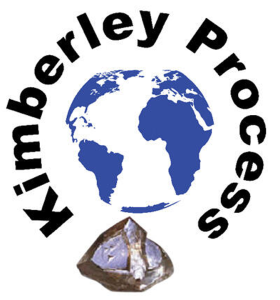 The Kimberley Protocol was an agreement by many nations that action was needed to stop the use of diamonds to fund wars and terrorism throughout the world. This protocol gave rise to the Kimberley Process, which are the regulations that have been adopted regarding the sale and distribution of rough diamonds around the world.
The Kimberley Protocol was an agreement by many nations that action was needed to stop the use of diamonds to fund wars and terrorism throughout the world. This protocol gave rise to the Kimberley Process, which are the regulations that have been adopted regarding the sale and distribution of rough diamonds around the world.
The Kimberley Process was implemented in January of 2003, and states that all rough diamonds must come with a certificate of verification, issued by a proper government authority to insure that they are from a non-conflict source. The diamonds must be packed in a specially marked container. And all legitimately registered diamond dealers may only do business with other registered diamond dealers, and all must follow the above rules for all diamond shipments sent and received. The idea is that if the diamond industry only buys diamonds from known sources that are selling government approved diamond rough that has been legitimately verified, that the conflict diamond market will fade away.
Well….this looks good on paper. And it plays well in the media. However, many in the diamond industry know that this is going to have little impact on the conflict diamond issue. Currently there is no method available to identify a diamond as being from one source or another…as we can do with rubies, sapphire, etc. Small impurities in colored gemstones allow a fairly easy identification as to their source if one has the proper equipment. Not so with diamonds. As of this writing there is no known method of identifying diamonds based on geographical origin. So, it would be very easy for just one unscrupulous diamond dealer to do business with the bad guys and create an inroad into the legitimate diamond markets for conflict sellers. While that scenario is probably closer to the truth than anyone wants to admit, it is still an extremely small part of the overall diamond market. So much so that the efforts to prevent the actions have almost created a situation where the fix is worse than the problem.
The problem here is that too many activists want to ruin the whole diamond market for the sake of a few problem diamond sources.
The reason that this is true is due to many activists wanting to blame the entire diamond industry over the actions of a few militias in diamond producing countries that are beyond the control of local government military efforts. And rather than going in and solving the problem of the militias on a military level, all too many people want to blame the diamond industry for the funds received and try to control the problem through the diamond markets rather than through proper governmental and military action. The end result is that diamonds and the diamond industry are being blamed for actions beyond our control, which should be dealt with by local governments rather than the world diamond industry.
We can only hope that the Kimberley Process will serve its intended purpose at some point in the future. The last chapter of that story is yet to be written, and probably won’t be for some time to come.
The Current Diamond Market
 The future of the diamond industry is in limbo. For while De Beers has controlled distribution and prices for over a century, the fact remains that diamonds are quite plentiful, and De Beers is quickly losing that strangle hold on the markets and prices. Yes, diamond prices continue to hold at fairly average levels, but that is due to a worldwide effort to continue the monopolistic pricing structure of the diamond market. It simply serves every diamond producer’s best interests to abide by the prices set by De Beers. But is that going to last?
The future of the diamond industry is in limbo. For while De Beers has controlled distribution and prices for over a century, the fact remains that diamonds are quite plentiful, and De Beers is quickly losing that strangle hold on the markets and prices. Yes, diamond prices continue to hold at fairly average levels, but that is due to a worldwide effort to continue the monopolistic pricing structure of the diamond market. It simply serves every diamond producer’s best interests to abide by the prices set by De Beers. But is that going to last?
The influence of lab-created diamonds is reshaping supply chains, marketing strategies, and consumer preferences. Major jewelry brands have begun to embrace these stones, offering extensive collections that cater to evolving tastes and principles. The influx of lab-created gems has increased competition and pressured the pricing of natural diamonds, leading to a gradual decline in market values for certain categories. Meanwhile, consumers are becoming more discerning, seeking transparency about origin and production methods. The industry is responding with greater emphasis on certification, traceability, and education to help buyers make informed choices. As sustainability and ethical sourcing become central to the conversation, the diamond market’s future will likely hinge on how effectively traditional players adapt to these innovations and the shifting expectations of a new generation of customers.
.
